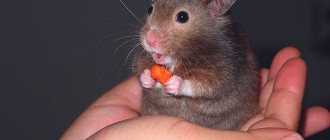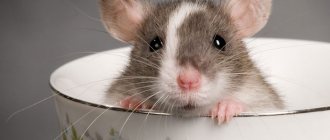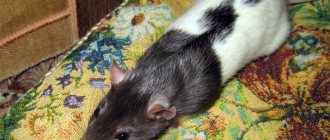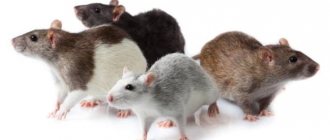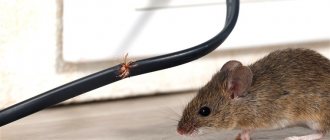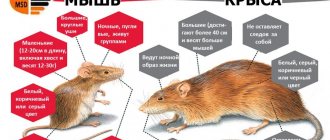Next you will learn:
- What are rats and mice really afraid of and how can it be used in practice;
- What is useful to know about ultrasonic rodent repellers and what you should pay attention to when choosing them;
- In what cases can even the smell of a cat scare away rats for a long time and what is observed in situations where the cat itself is more afraid of rodents than they are of it;
- Are rats afraid of light and loud sounds and should you count on this when fighting rodents?
- Is it possible to somehow use rats’ own danger signals by recording them once, for example, on a phone;
- What insulation materials do not like and are not chewed by rats and mice;
- Is it possible to reliably scare away rats using some odorous herb or household chemicals...
The idea of scaring rats out of the house or basement appeals to many. At a minimum, this seems simpler, safer and more humane than fiddling with rat poison or rat traps, then removing caught rodents (and sometimes still alive) from traps.
Meanwhile, many people are skeptical about attempts to scare away rats - some are convinced that these animals are too smart to be afraid of repellents, and some even proudly claim that our “domestic” rats are practically not afraid of anything at all, and means that are confidently used abroad simply do not work in Russia.
In fact, rodents can indeed be quite effectively repelled, and problems in fighting them in practice are often associated either with the fact that people do not know what rats are afraid of, or do not use the appropriate means correctly. For example, many folk remedies do not work at all and do not allow you to get rid of rodents, although myths about the effectiveness of a number of recipes that are simply copied from site to site without any checks are actively circulating on the Internet.
Also, many ultrasonic rat and mouse repellers, especially the cheapest ones, suffer from ineffectiveness or complete uselessness in the fight against rodents (especially the so-called “electromagnetic” and “magnetic resonance” repellers). At the same time, there are quite effective devices on the market that, when used correctly, in many cases really help get rid of rodents in the house.
On a note
Even if you know exactly what smell rats and mice don’t like, this cannot always be used in practice to remove pests from the house. For example, rodents definitely do not like the smell of cat urine and ammonia (ammonia). But if this kind of smell is frantically used to repel pests, then you can bring your own home to such a state that it will be impossible to stay in it. And it is still unknown who will be able to scare off first - rats, or people who decide to come to visit you...
Therefore, it may be advisable to use against rats, first of all, those means and methods that really frighten them, but which are quite normal for humans. By the way, there are not so many such means that “terrify rats.”
What rats are really afraid of and don't like
Perhaps the main problem of repelling rats is that, with rare exceptions, these animals are afraid of the same smells and sounds that are unpleasant to humans. To get rid of rodents without disturbing your comfortable living indoors, you should use means that are familiar to humans or completely invisible, but which rats cannot tolerate.
Among them:
- Ultrasonic rodent repellers (high-quality, not Chinese tweeters) - people do not hear ultrasound, but rats perceive it and at a certain frequency and intensity - they are afraid (more precisely, they experience discomfort);
- Cats (and to a lesser extent, their smell);
- Bright light (provided that the animals are not used to it);
- Loud sounds;
- Sounds with which rats themselves transmit danger signals to each other.
A common disadvantage of such influences is that rats can get used to them, and the longer a particular sound or smell affects rats, the less they can be afraid of it. This means that when using one or another option, you should always take into account the likelihood of rodents developing individual immunity to deterrents.
Fortunately, addiction in animals does not develop very quickly, and it is often possible to drive them away long before they become immune to one or another influence.
On a note
To effectively fight rodents in a private home, it is also useful to know which insulation is not chewed by rats and mice, since the wrong choice of insulation can create ideal conditions for rodents to live in the walls of the house and in the attic. We’ll talk about this in more detail below, but for now we’ll just note that, contrary to popular belief, glass wool in most cases is not able to scare away rats - rodents can easily make their moves in it.
Rat briquette
It is also characterized by high efficiency. When exposed, rodents begin to die within a couple of days. A similar substance is used as bait.
The advantages include the following points:
- Has a suffocating effect. In this case, the rats escape into the open air and do not die indoors. A relatively small number of drugs have this property.
- The possibility of a cadaveric odor is eliminated, since the rats leave it before the moment of death.
- Long lasting use. The drug is effective for several months.
- The price of the drug is slightly higher than others, but this is due to its effectiveness.
Ultrasound and methods of its application
Rats and mice hear sound with a frequency of up to 80-100 kHz, while humans are no longer practically unable to perceive vibrations with a frequency above 20 kHz. Sound with a frequency above 20 kHz is called ultrasound, and it meets one of the requirements for rodent repellents - to affect rats and mice without affecting humans.
It has been verified that devices that emit sound waves with frequencies from 20 kHz to 70 kHz can indeed repel rats quite effectively. In this case, an effective repeller must not only generate ultrasound, but also have a number of other important characteristics.
Here are the most significant of them:
- High sound pressure (a parameter similar to volume, but in the ultrasonic range). The higher the sound pressure, the higher the likelihood that rats will not tolerate the sounds produced by the device and will leave the area;
- The wide directional pattern of emitted ultrasound determines in which direction and how widely the sound travels. Ideally, it should approach 360°, that is, in fact, ultrasound in this case will spread evenly around the entire repeller. Most devices claim this angle, but in fact their ultrasonic radiation pattern barely reaches 50°;
- Automatically changing ultrasonic frequency. It is important to understand that not all ultrasound scares rats. Just as not every sound causes discomfort in humans, not every ultrasound repels rodents. But if the device constantly changes the frequency of the emitted ultrasound, then periodic discomfort will not be avoided for rodents.
The most effective ultrasonic repellers against rats today include Biostrazh, Chiston 2, Chiston 2 PRO, Tornado 800, TM-315 and some others. They are also one of the most expensive. More affordable devices are not as powerful, and some of the cheapest ones are outright junk, useless and not at all capable of scaring rats.
In addition, rats can get used to ultrasound, just like any other sounds. This, although rare, does happen. In this situation, pests may leave the room at first when the device is turned on, but then they will return again.
It is also useful to read: Using electric rat traps to control rodents
Ultrasonic repellers, when used correctly, do not have a negative effect on people, but may cause headaches for some. It should also be taken into account that cats and dogs hear ultrasound well, especially domestic mice, rats and hamsters, and therefore if there are pets in the house, such a device may not be able to be used.
At the same time, a cat itself, and sometimes a dog, is often a much more effective “repellent” of rats and mice...
Behavior of rodents when the ultrasonic device is turned on
Experiments show that when the device is turned on, mice immediately tend to leave the room in panic. During the experiments, they rushed around the cage, threw food and water, and hid in far corners. In life, rodents may try to hide in places protected from sound, but they often run away.
A mouse infestation is an unpleasant and dangerous situation, and it is important to act quickly. Humane repelling of rodents involves using ultrasound or a strong odor that mice are afraid of.
You can use dry and fresh herbs, essential oils and spices, and plant certain plants on the site.
Cats and their smell in the house
Everything is simple here: cats are the natural enemies of rats and mice, and therefore rodents avoid places where there are fresh traces of cat activity. Even if a cat does not hunt pests in the house (which often happens with pampered pets), rats are afraid of their smell, which reduces the likelihood of rodents, but does not guarantee their complete absence.
It should be noted that although we are talking about the smell of a cat, this does not mean that all the walls and furniture in the apartment should be thoroughly saturated with the pungent aroma of cat urine. Rats have a keener sense of smell than humans, and they are afraid to enter rooms with a cat, where a person may not feel any odors at all. And if the owners of the house forget to change the litter in the tray from time to time, the corresponding aroma will literally “hit the rats’ nose”, and they will prefer not to run into the room again.
If a cat does not catch rats, they can get used to its smell over time and calmly tolerate such proximity. In this case, rats usually simply live in the same house as the cat, but avoid direct encounters. Particularly impudent rodents can demonstratively go about their business in full view of the cat, and sometimes even attack it.
Here, by the way, a lot depends both on the character of the rat itself and on the experience of the cat. It happens that cats are afraid of rats because they have never met them in their lives and do not know how (and most importantly, why) to catch these neighbors in their housing. Pets who grew up in apartments and have never obtained natural prey behave this way especially often. Even experienced, but lazy and always well-fed cats do not hunt rodents simply out of laziness, and if rats behave particularly impudently, they may even be afraid of them. It is in such cases that various comical situations arise when a rat can scare cats or even drive them away from food.
Normally, cats are not afraid of rats, and if you do not overfeed them, they actively hunt them for fun and fresh meat. In rural areas, cats are specially fed only from time to time so that they switch to pasture and feed on pests in the house and garden.
From all of the above, we can conclude: rats are afraid of cats when they hunt them. The cat itself and its smell can scare off pests at first, but once the rats understand that the cat poses no danger to them, it’s just a matter of time before the rodents move into the house.
On a note
Generally speaking, rats are afraid of people, dogs and any other large animals (including birds - turkeys, geese, guinea fowl and chickens) that they see for the first time. If animals meet people somewhere over and over again and get used to the fact that they are not hunted, then they stop being afraid and often become very arrogant. There are known cases when rats stole food from the table right in front of people, or from a dog’s bowl - from under the nose of the dog himself.
It is also interesting that mice are afraid of rats, since rats, as larger predators, pose an immediate danger to them. However, this fact is not useful in practice in the fight against rodents.
Pest prevention
Dealing with a rat infestation is a difficult task that requires an investment of money and nerves. Isn't it easier to prevent proximity to parasites? Remember that rats and clutter are two closely related things, so follow simple rules and pay due attention to cleanliness.
Adhering to useful recommendations and “getting acquainted” with rodents does not promise you:
- regularly clean the area near your house; the presence of freely accessible garbage is an invitation to rats;
- Monitor the condition of the garden and trees. The presence of garden waste attracts rodents, and later they will want to move into the house;
- carefully inspect the house for cracks, holes, and other openings that could become a way for a rodent to enter the room. Use a fine metal mesh and seal all existing ventilation ducts with it;
- Pay special attention to water sources in the house and near it. Rats need water daily; its absence will scare away uninvited guests. Fix leaking pipes in the house, close the toilet lid at night;
- Do not leave pet food bowls out overnight;
- Store all food supplies in tightly closed containers, do not leave crumbs on the table, and do a thorough cleaning of the house at least once a month.
Simple rules will help protect your home from rodents, even other parasites that can significantly ruin your life.
Rats are dangerous parasites that require constant control; if several individuals are not exterminated in time, you will have to deal with a huge infestation of pests in the house. If necessary, involve your neighbors in the fight against rats; this issue is especially relevant if rodents are found in a multi-story building.
Find out more effective ways to control rats in the following video:
Light
Rats are nocturnal animals, and other things being equal, they prefer to be in dark places and go out in search of food at dusk and in the dark. However, they easily and quickly adapt to light, and if they do not encounter any dangers in illuminated places and in bright rooms, they quickly cease to be afraid of light. Often, rats become diurnal and forage in daylight.
This means that although in general rats are afraid of light, it will not be possible to use this as a permanent repellent. If you leave the light on in the room, then after a few days the animals will stop paying attention to it.
On a note
Interestingly, due to the specific nature of their vision, rats do not perceive infrared light. In zoos, this is used to switch nocturnal rodents to daytime mode: during the day a red light is on in the enclosure, and the animals believe that they are in the dark, and at night a regular incandescent lamp is turned on, and the rodents go to sleep. As a result, visitors during the day can observe animals that lead a nocturnal lifestyle.
How vinegar will help get rid of mice in the country
It is quite difficult to get rid of mice in a summer cottage, since their distribution area is wider. In this case, you will have to use 70% vinegar for better effect.
Author's note Olga Kirilova
When processing, wear a mask to prevent the smell of acid from burning your respiratory tract and causing headaches.
Processing process:
Purchase 5-6 bottles of acetic acid 70% at once. It must be chemical and unsuitable for food. Pour the liquid in large quantities into several enamel containers. Place around your dacha area
Pay special attention to the premises. Even those of them that are in desolation.
The smell will scare away the mice and they will run away. This method is suitable for processing only if you do not plan to spend the winter at the dacha. Otherwise, the strong aroma of acid will harm your own health. Processing is carried out in the autumn. In spring, you should remove all containers and ventilate the room.
There is an old kettle left at the dacha, don’t rush to throw it away. Find out how to properly descale a kettle with citric acid and it will still serve you well.
Loud sounds
This factor is very specific: rats are really afraid of loud sounds, but it is inconvenient to use them in a living room. As an exception - loud music, in which pests will not dare to get out of their hiding places, but it is impossible to listen to it around the clock, and at night, in silence, the animals will calmly rule in the kitchen or basement.
On the other hand, rats are afraid of noise only until it becomes familiar to them. And they get used to different sounds quite quickly, especially if you try to scare rats often and regularly. Therefore, to scare away rodents, it is irrational to use ordinary sounds audible to humans.
On a note
Like most wild animals, rats, even indoors, are also afraid of quiet sounds - various rustles and creaks. This is understandable: in the wild, a predator always creeps up on its prey quietly, trying to make a minimum of sounds, and therefore the quiet crack of a broken twig under its paw or the rustling of leaves foreshadows great dangers for the rat.
At the same time, at large industrial enterprises - grain warehouses, transshipment depots, ports - rats calmly collect grain under trucks with running engines, run under rumbling conveyors with vegetables and nuts, and do not pay attention to noisy presses at oil extraction plants. They know that these particular noises do not pose any danger to them.
Classification of “fears”
Over the thousand-year history of forced proximity to pests, man has come up with a hundred methods that can not only repel mice, but also drive them out of the house. If we classify these methods by type, we can distinguish three areas:
- natural enemies, that is, cats and natural predators;
- repellents, or, in simple terms, repellent odors, they can be of both natural and synthetic origin;
- physical methods of influence, in particular sound vibrations in the air, caused, for example, by hitting a sneaker on the floor. Although, as a stunning element, it is easier to use special devices based on ultrasound, which is elusive to the human ear.
Rat "screams of terror"
Like some other animals, rats can be repelled by playing their own danger signals. This method is sometimes used to scare away birds and to control monkeys on tropical farms. Once a recorded cry of danger is enough to use it almost constantly and effectively.
It is also useful to read: Choosing an effective electronic rat and mouse repeller
However, some rules must be followed:
- The sound should not be played regularly so that the animals do not get used to it;
- The sound should be clearly audible throughout the room;
- The actual cries of danger must be recorded, and not just squeaks;
- Recording and reproducing equipment must capture the ultrasonic frequency range.
In domestic conditions, the implementation of this method will in most cases be ineffective. Firstly, using a smartphone or computer microphone to record rat squeals is not the best option, since the ultrasonic component will not be recorded at all (even vibrations above 15-17 kHz will be recorded with distortion). Secondly, reproduction will also require emitters (speakers) capable of reproducing ultrasonic vibrations without significant distortion. Well, and thirdly, few people would want to live in a house where a loud rat squeal is constantly suddenly heard.
The use of ultrasonic rat and mouse repellers in this regard would be more justified.
On a note
People know the harsh old-fashioned way of scaring away rats: they used to simply catch a live rat and nail it to the wall. While the animal was dying, its relatives heard the terrible screams of its agonizing fellow. However, for humane reasons, such a method should in no case be considered for practical implementation.
Traditional methods of fighting mice
If for some reason you suddenly do not want to use industrial poisons or mousetraps to eliminate mice, the methods outlined below will be useful to you.
Get a cat. If this is possible, then a good cat will be able to destroy a fairly large number of mice.
As a rule, a cat's efforts are quite enough for an apartment. If you don’t want to get a cat, you can borrow one from someone.
Fight mice with scents. Mice cannot tolerate certain strong odors.
For example, these are the smells of mint, bay leaf, ammonia, acetic acid. If you know what smell repels mice and can tolerate it yourself, you can use it to control mice.
For example, bay leaves can be laid out in cabinets and on shelves, pieces of cotton wool can be soaked in ammonia water or vinegar and placed in corners.
This method is also suitable for killing mice: you need to mix plaster or cement with flour.
Pour the resulting mixture into a plate and place it near the mouse hole or in their approximate habitat.
You can place a plate of water nearby. After the mice eat the “gift”, it will harden in their stomach with all the ensuing consequences.
You can also use crushed glass for this purpose - it perfectly kills both mice and other animals. The good thing about such methods is that the “ingredients” used are not poisonous.
Instead of industrial poison, you can use copper sulfate - although it is toxic, in small quantities it will not cause significant harm to the environment.
Other aggressive substances are also good - you can give free rein to your imagination.
The main thing is to get the mouse to eat the “treat”.
What insulation materials do not like and are not chewed by rats and mice?
There are several types of insulation that are a fairly reliable barrier to rats and mice in private homes. It would not be entirely correct to say that pests do not like them or are afraid of them - rather, they simply cannot gnaw through such materials, and if they can, they usually do not do it.
Among them:
- Foam glass is insulation that rats do not chew due to its hardness;
- Expanded clay of different fractions - for the same reasons. Although, the smallest expanded clay used for dry screed is not always a reliable barrier for rats and mice - although they do not like such insulation, they are able to rake and make their way through its layer to the floor covering;
- Foam concrete - it lends itself to rat teeth, but due to the presence of cement in the composition, animals do not like it and do not gnaw it;
- Ecowool is an insulation material that, due to the toxicity of the impregnation components (boric acid), is unattractive to rats and mice.
But rats are not afraid of the notorious glass wool. Even more than that, they willingly make nests and shelters in it, easily make passages here, and the crushed glass in the material does not seem to bother them at all. Other mineral insulation materials are similar to glass wool, including those made from basalt fiber, as well as polystyrene foam, polyurethane foam and penoizol - animals willingly live in them and raise their offspring.
Why does the water supply valve filter become clogged?
To extend the life of your washing machine and filters, follow these preventive measures:
- Clean parts regularly, removing debris, small objects and other contaminants;
- use high-quality powder and fabric softener;
- Before loading the drum, check the pockets of things, removing all contents from them;
- Wash clothes with decorative elements (beads, sequins, beads) in a special bag.
We invite you to familiarize yourself with Washing machine connection power
Proper care of your washing machine and regular cleaning of filters will extend the life of the unit.
Herbs used to repel rats
A big temptation for many people is the idea that you can take some kind of herb against mice and rats, which supposedly just needs to be laid out in different places in the room to forget about these pests once and for all.
Among folk remedies for rodents, it is recipes with certain herbs that can be found most often. Thus, it is believed that mice and rats are afraid of:
- Mint, fresh or dried;
- Beans (especially roasted seeds);
- Blackroot - any parts of the plant;
- Elderberry, mostly bunches of its berries;
- Hot pepper, both in pods and ground;
- Chamomile flowers;
- Tansy - its inflorescences, maybe in bunches with grass;
- Wormwood is also mostly a dry herb.
However, the main drawback of the herbs recommended to repel rats and mice is that the animals very quickly get used to their smell, or, in the case of poisonous plants, stop gnawing the grass. Even if one or two animals are poisoned by the same blackroot, the rest of their relatives will not leave the room, but will simply avoid the suspicious bait.
blackroot plant
The common name for all types of blackroot goes back to Ancient Greece. Because of its elongated, rough leaves, the ancient Greeks called blackroot “dog’s tongue.” Later, the Romans adopted the tradition, so in modern reference books the plant has the Latin spelling “Cynoglossum”.
Types of blackroot
Today, scientists count more than eighty species of blackroot, most of which grow in the tropics and subtropics. Less than ten species are found in our latitudes. But they are widespread everywhere.
All types of blackroot are distinguished by a soft covering of green parts in the form of small short fibers. The root of the plant grows deep into the ground and has a spindle-shaped shape. Blackroot blooms in paniculate inflorescences, and the ripening fruits are nuts with curved spines.
In ancient times, mystical properties were attributed to black root decoction. They sprinkled it on the walls of houses and pens for domestic animals. It was believed that the smell of the broth drove away not only mice, but also evil spirits.
Folk remedies whose repellent abilities are questionable
Folk art is replete with ideas and recipes for remedies that rats should supposedly avoid, but in practice this often does not happen.
Here are just the most famous of them:
- Vinegar - It is believed that rats are afraid of it due to its strong, unpleasant odor. Some even try to use vinegar essence, which is unsafe to use, for this purpose. At the same time, however, it is silent that not only rodents, but also the residents of the premises will have to inhale the aroma of vinegar;
- Essential oils and perfumes. It is highly doubtful that the animals that have conquered the whole world from India to the USA would shy away from the exquisite aromas of world-famous perfume houses or the smells of essential oils. Such means can alert them, but are not able to drive them out of the house;
- Bleach - Rats actually avoid places that smell too strongly of bleach (bleach releases small amounts of chlorine gas into the air, a very caustic, poisonous gas). However, the active use of bleach in an apartment or house is a dubious idea, since the residents themselves will have to inhale such an aroma. In addition, the duration of action of the product is short, since bleach quickly loses its activity in the air;
- Naphthalene - rats are not always afraid of it, and, moreover, this same product is recognized as a carcinogen and is prohibited for use in residential premises;
- Ash. The use of ash to repel rats is a typical folk myth, since it does not cause any fear or particular discomfort in rodents;
- Broken glass falling asleep in rodent passages is also a kind of unfounded legend;
- The smell of burnt rubber and burnt fur - such folk remedies may indeed frighten rats once, but they are not capable of becoming a reliable permanent means of fighting them;
- Turpentine, kerosene and gasoline - the same applies to them as to vinegar. And in addition, they are also fire hazardous;
- Burdock thorns, which supposedly frighten animals by clinging to their fur. Actually ineffective;
- Tobacco or cigarettes - despite their strong smell, they practically do not repel rodents.
On a note
In general, rats are not afraid of water (moisture) and cold. They feel great in damp basements, can swim for a long time (in nature they are known to catch ducklings and frogs in the water), and can easily tolerate the cold if they have access to food sources. Situations have been described in which rats lived for several generations in freezers at an air temperature of -18°C, breeding inside frozen pork carcasses. Therefore, airing a house or apartment in winter will not help get rid of rats.
Interesting video: how to remove rodents that are not affected by poison and are afraid of public utilities
How to drive rats out of non-residential premises
If it is necessary to expel rats from a non-residential premises, for example, a bathhouse or a barn, then you can use products that emit a strong odor. And here we are not talking about special chemicals. But what smell are rats afraid of? Let's look at this issue in detail.
Vishnevsky ointment
It must be diluted with water to obtain a thick consistency. The resulting mixture should be spread on the floor in a non-residential area and closed for several days. It is important to note that Vishnevsky’s ointment is not suitable for external treatment.
Singed wool
It is necessary to burn natural fur over a fire and bring it indoors. Also suitable for this method are fluff or burnt rubber. It is installed next to the minks.
Various substances
These include:
- kerosene;
- tobacco;
- vinegar;
- bleach;
- hot peppers.
Do not forget that during the treatment all animals and birds should not be allowed into the room, and after the treatment the building must be ventilated.
Herbal essential oils
In pharmacies you can buy essential oils that are prepared from herbs. The aroma from the essential oil will be stronger and richer than from fresh or dried herbs. It will be felt longer.
It is known that rats are afraid of the smell of peppermint essential oil. The same goes for mice. The oil is dripped onto cotton pads or napkins and placed in the corners of the rooms.
You can drop a few drops into the water before washing the floors. The smell will be felt throughout the house, so you shouldn’t overdo it. The pungent aroma causes headaches and dizziness.
In addition to mopping the floors, you can diffuse essential oil from a spray bottle. To do this, drop from 1 to 15 drops of oil into 300 ml of water and add 10 ml of alcohol. The mixture is applied wherever animals may be.
Special aroma lamps are sold in stores. The essential oil evaporates along with the smoke, and the smell penetrates into all the cracks.
Direct contact of the animal with the oil must be avoided. If it gets on the fur of a rodent, it will lead to death. For lovers of humane methods of elimination, murder is definitely not suitable.
Plant control
Representatives of previous generations knew what grass mice and rats are afraid of. The repellent smell forces them to leave human possessions. The presence of the potion protects against re-infection
Expulsion from non-residential premises
Several plants have been used since ancient times, which have repeatedly proven their effectiveness. Application does not require special skills, but caution is required:
- Elder. They lay them out along the walls, in the corners, and stuff them into holes. Protection is updated after a week. At the dacha, in the garden, an elderberry bush is planted. You don't have to invent anything with smells. In an apartment or residential building, elderberry is used with caution, since the plant contains toxic hydrocyanic substances. It is forbidden to use this herb against mice if there are animals or small children in the house.
- Ledum. The poisonous properties of wild rosemary have been known for a long time. The plant not only repels mice and rats with its smell, but can also kill. Ledum essential oils are hazardous to human health and are recommended for use in non-residential premises, warehouses, barns, and garages. The repellent smell lasts about 10 days.
- Blackroot officinalis. No plant can compare with this potion in terms of effectiveness. The potion is popularly called a rat killer. The plant has a sharp, repellent odor, as well as many spines that contain poison. Upon contact with blackroot, the spines cling to the fur of rodents, dig into the skin, and release toxic substances. Rodents are most afraid of contact with this plant. To poison pests, the seed is mixed with flour and sugar.
Plants against rodents
Important!
When working with a dangerous potion, you must protect your hands with rubber gloves and wear a gauze bandage. The black root is dipped in boiling water for a few minutes and placed in the right places.
The repellent effect of the plants lasts as long as the aroma lasts. With its disappearance, performance decreases. Bundles of potion should be renewed periodically to maintain the smell. It is also necessary to alternate scents, since with prolonged use, pests become addicted.
Expulsion of rodents from residential premises
Plants against rats and mice are used in apartments and houses. But they use a potion that is safe for human life and health:
- sagebrush;
- pharmaceutical camomile;
- tansy;
- peppermint;
- pyrethrum.
The smell of chamomile, mint, and pyrethrum has a beneficial effect on a person’s well-being - it calms the nervous system, normalizes sleep, and improves breathing. For rats and mice, the smell is one of the most annoying and unpleasant.
Anti-rat grass in the house The plant is placed around the perimeter of the rooms, in the corners. You can use dry potion, fresh. But it should be updated as the smell disappears. For greater efficiency, create a bouquet of several components.
You need to be careful with tansy and wormwood. The rich smell of these plants drives rats and mice out of the room in a matter of days, but can harm humans. Headache, nausea, weakness, and sleep disturbance appear. To avoid this, you need to distribute the potion in small quantities. Rodents' sense of smell is much sharper than that of humans; they detect even the faintest odors.
On a note!
Instead of plants, you can use essential oils to repel rats and mice. Drop onto a napkin, add to water for washing floors, apply to a light bulb, saturate a candle or wood. Carrying out the daily procedure in the evening makes life unbearable for pests, but for humans it will smell pleasant. After a few days the animals will leave the premises.
You can create living protection around the house - plant mint bushes around the perimeter, spread chamomile, tansy, or other fragrant herbs. Plants prevent rats and mice from leading a full life; you can get rid of them without using dangerous poison.
Additional methods
You can scare away rats with harsher substances. Among the folk remedies you can find turpentine, kerosene, cologne, ashes from the skins of killed rats, etc. All substances are toxic and have a pungent odor. Therefore, the use of most products in an apartment or residential building is impossible.
Kerosene
It is recommended to spray the habitats of parasites with kerosene. In basements and attics it makes sense to install a container with liquid. The smell of fuel will emanate constantly. Therefore, rodents will try not to return to their habitual place. If the animal gets into the liquid, it will die.
Naphthalene
Naphthalene has a sharp, specific odor. The solid substance not only repels rodents, but is also toxic to them. It is recommended to mix naphthalene with sawdust and scatter the mixture in mouse habitats. Such flooring will cause animals to panic and try to leave the room. It is recommended to use mothballs to remove rodents from non-residential premises.
Turpentine
Turpentine has a similar effect to kerosene. The liquid has a pungent odor that causes discomfort to living beings. It is recommended to coat the corners of the room with turpentine, or place a container with it next to mouse holes. The aroma of fuel persists for a long time and does not dissipate well, so rodents do not appear for a long time.
Burnt fluff
Burnt feathers are another effective method of repelling parasites. Pests cannot tolerate the smell of burnt fluff and avoid its locations. You can burn any feathers. Duck down has the most unpleasant aroma. Ashes must be mixed with starch and scattered in places where rodents have been seen.
Burnt rat fur
It is believed that rats are acutely aware of danger. Therefore, people have been using the method of repelling rodents for many years, which involves the use of the corpses of their relatives. Killed rodents must be skinned and burned. After this, the singed wool becomes the most terrible rat repeller.
Cologne
Cheap cologne, which you can buy at a department store, is an effective mouse repellent. The perfume has a sharp and persistent odor. Sensing the aroma, rodents try to retreat. It is recommended to use cologne not only in outbuildings, but also in apartments.
Chlorine solution
Bleach and chlorine-containing substances not only repel rats, but also kill them. Experienced housewives place jars of whiteness around the house. They prevent rats from leaving their holes. If the liquid enters the body, the animal dies.
Jars with chlorine solution must be covered with a plastic or metal lid, after making several holes in it.
Glass wool
Glass wool does not emit an odor, so it is used in residential areas. Insulation is added to food baits, which must be placed near mouse holes. Once in the body, glass wool injures the rodent's stomach. This causes instant death of the animal from internal bleeding.
Glass wool can be added to the soil mixture and sprinkled over the paths along which mice move.
What pets will help get rid of rodents?
Of the domestic animals, mice are most afraid of cats. These small domestic predators can kill up to 57 rodents on average per year. In most cases, when contacted by a mouse, the cat immediately attacks it; it either kills its own victim or plays with it until the latter dies. Cats do well with all types of rodents, with the exception of large gray rats, since the latter often exceed their size.
Also, domestic mice are afraid of some breeds of dogs. Like cats, these animals protect their territory and try to exterminate any living creature that enters it.
As for people, mice are afraid of them, but only partly. Rodents try not to catch their eye, but easily settle in their homes.
Let's dispel the myths
Are folk remedies for mice effective? Home remedies, in fact, do not work at all. You will probably notice a temporary effect and perhaps a decrease in the number of pests, but these methods will not permanently get rid of mice.
Rats and mice are quite smart creatures. They know they live in a dangerous world as soon as they find a place where they can live safely from predators, have access to water and food, and would rather put up with ultrasonic waves and mint than risk leaving their new home.
Naphthalene.
It is a strong-smelling white solid. When inhaled or swallowed, blood cells lose their ability to carry oxygen. It was believed that placing mothballs near mouse nests would get rid of the rodent problem. However, it is not. The amount contained in tablets sold in stores is sufficient to kill moths and other insects, but not mice. The level of substance required for rodents should be the same as for humans. The mice won't pay any attention to it.
Even if rodents are bothered by this smell near their entrance, they will soon find or gnaw another one, a hole the size of a coin is enough for them.
And will you be happy if all your things smell of a specific aroma?
Mint.
The rooms are filled with a pleasant aroma that gets rid of mice, making it an ideal repellent? WRONG!
As in the first case, this is only possible if there is a high concentration, because mice have a sensitive sense of smell. Logically, mice live in all areas, including sewers. If they can put up with the smell coming from the smelly sewer system, then peppermint won't give them any problems.
Other folk remedies for mice are just as unreliable; let’s add hunting cats to the exception.

